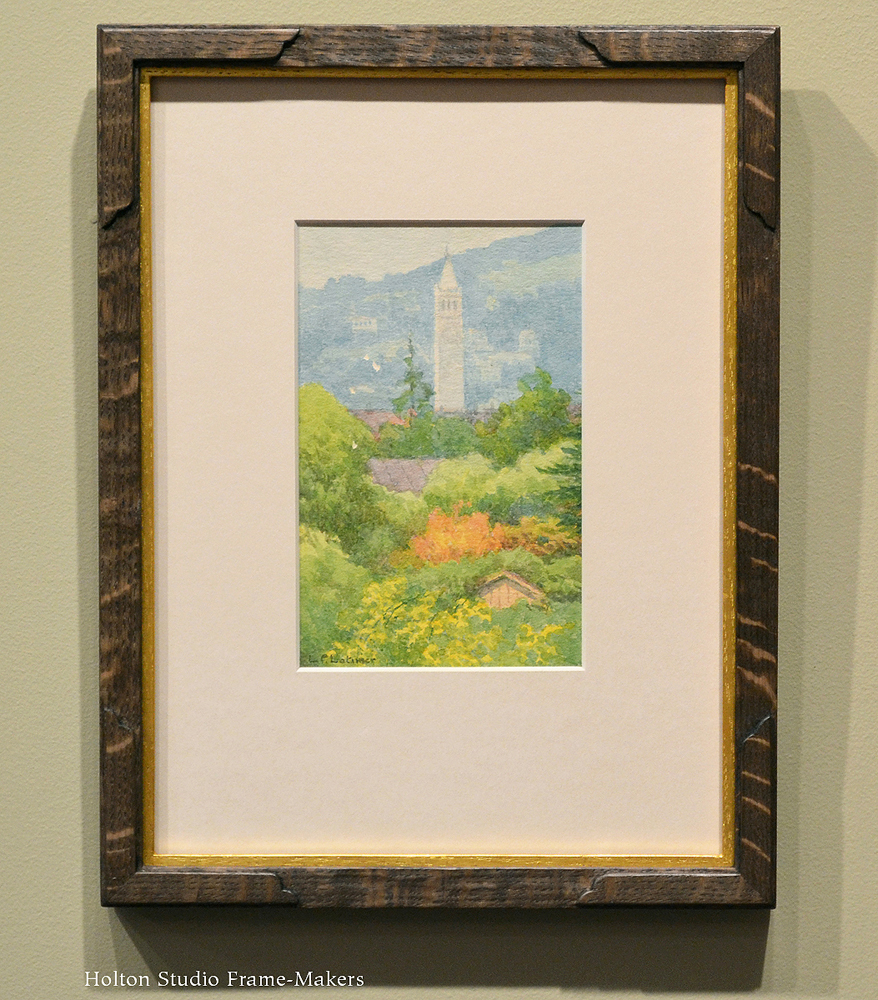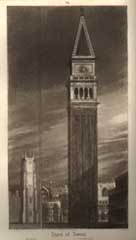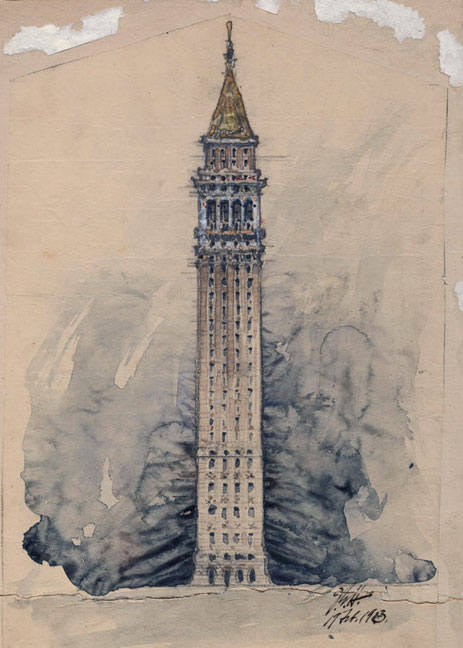Just framed this undated watercolor by Lorenzo Latimer (1857-1941) depicting Sather Tower, more commonly known as the Campanile, at UC Berkeley. Because I was born and raised in Berkeley, this picture and its subject are close to my heart. Designed by John Galen Howard, the tower is 100 years old this year—the same age as the Palace of Fine Arts painted by Lucia Mathews in the beautiful gouache featured two posts back. Inspired by the famed Campanile on Piazza San Marco in Venice, Howard began designing Sather Tower in 1903, just six months after the Campanile in Venice mysteriously and suddenly crumbled to the ground. We can only speculate on Howard’s thinking, but the sense of loss, not only to Venice but the world, surely focused the minds of architects on the meaning and purpose of such towers, which have served noble civic purpose as beacons, bell-towers and gathering places.

Lorenzo Latimer, untitled (The Campanile, Berkeley), undated. Watercolor, 5-1/2″ x 3-1/2″. Framed in No. 15 CV Panels (scallop pattern)—1/2″ in quartersawn white oak (Weathered Oak stain), with gilt oak slip.
 Latimer’s image frames the Campanile within the surrounding natural landscape, the the central and focal landmark of the campus rising above Berkeley’s treasured trees, and is reminiscent of a line by the great architectural scholar, John Ruskin. (His sketch of Venice’s Campanile is at right.) In his 1853 Edinburgh lecture, “Architecture,” Ruskin remarked on, “the beautiful effect of [South Switzerland’s] gray mountain churches, many of them hardly changed since the tenth and eleventh centuries, whose pointed towers stand up through the green level of the vines, or crown the jutting rocks that border the valley.” This aspect of the picture—the harmony of the building, despite its monumental quality, with the surrounding landscape—suggested the quartersawn oak frame (our No. 15 CV Panels) and the pattern of its carved corners.
Latimer’s image frames the Campanile within the surrounding natural landscape, the the central and focal landmark of the campus rising above Berkeley’s treasured trees, and is reminiscent of a line by the great architectural scholar, John Ruskin. (His sketch of Venice’s Campanile is at right.) In his 1853 Edinburgh lecture, “Architecture,” Ruskin remarked on, “the beautiful effect of [South Switzerland’s] gray mountain churches, many of them hardly changed since the tenth and eleventh centuries, whose pointed towers stand up through the green level of the vines, or crown the jutting rocks that border the valley.” This aspect of the picture—the harmony of the building, despite its monumental quality, with the surrounding landscape—suggested the quartersawn oak frame (our No. 15 CV Panels) and the pattern of its carved corners.
Towers had great significance for Ruskin, and his thoughts help explain their iconic quality. “I need not remind you,” he told his audience, “of the effect upon the northern mind which has always been produced by the heaven-pointing spire…” Since the Tower of Babel, he said,
whenever men have become skillful architects at all, there has been a tendency in them to build high; not in any religious feeling, but in mere exuberance of spirit and power—as they dance or sing—with a certain mingling of vanity—like the feeling in which a child builds a tower of cards; and, in nobler instances, with also a strong sense of, and delight in the majesty, height, and strength of the building itself, such as we have in that of a lofty tree or a peaked mountain. Add to this instinct the frequent necessity of points of elevation for watch-towers, or of points of offense, as in towers built on the ramparts of cities, and, finally, the need of elevations for the transmission of sound, as in the Turkish minaret and Christian belfry, and you have, I think, a sufficient explanation of the tower-building of the world in general.
Ruskin loved the romance of such edifices, evoked even by the mere names for them: “Have not these words, Pinnacle, Turret, Belfry, Spire, Tower a pleasant sound in all your ears?” The great medieval towns full of of such things indicated “joyfulness and exhilaration of spirit in the inhabitants of such cities, leading them to throw their roofs high into the sky, and therefore giving to the style of architecture with which these grotesque roofs are associated, a certain charm like that of cheerfulness in a human face.”
See the special website devoted to the Tower’s centennial…
You can read about another iconic tower about which Ruskin had much to say at my blog post, “What Ruskin Saw Framed in the Stones of Florence.”
« Back to Blog
John H Gadow liked this on Facebook.